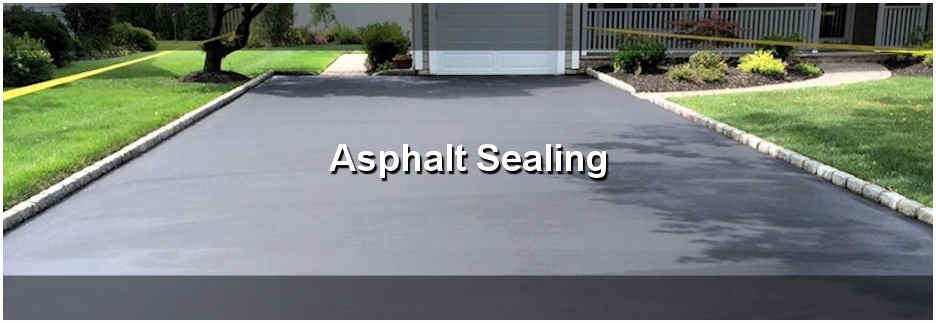Mastering Angled Parking: How Asphalt Sealing Improves Industrial Great Deals
Mastering Angled Parking: How Asphalt Sealing Improves Industrial Great Deals
Blog Article
Hot Mix Asphalt: A Lasting Service for Pavement
Hot Mix Asphalt (HMA) has become a leading sustainable option for pavement solutions, supplying a myriad of ecological benefits and cutting-edge technologies. Its capacity to reuse products and minimize power usage offers a compelling case for its adoption in roadway building and construction tasks. In addition, the long-lasting performance and durability of HMA make it a recommended alternative for facilities development. As the demand for eco-friendly building practices expands, checking out the subtleties of HMA's sustainability can supply valuable insights into the future of sidewalk services.
Environmental Advantages of Hot Mix Asphalt

In Addition, Warm Mix Asphalt assists to alleviate metropolitan heat island results. Its dark shade absorbs sunshine, minimizing the amount of warm mirrored back into the environment compared to lighter-colored pavements. This can lower ambient temperature levels in metropolitan areas, lowering the need for a/c and eventually minimizing energy intake.
Furthermore, Warm Mix Asphalt adds to enhanced stormwater management. Its permeable nature enables water to infiltrate the sidewalk and charge groundwater materials, minimizing runoff and the danger of flooding. These environmental advantages make Hot Mix Asphalt a sustainable choice for paving roadways and highways.
Energy Efficiency in HMA Manufacturing
Is power effectiveness a crucial variable in the production of Warm Mix Asphalt (HMA)? Definitely. Power plays a significant role in the manufacturing of HMA, impacting both cost and ecological sustainability. One vital facet of power performance in HMA production is the use of cozy mix asphalt (WMA) technologies (commercial parking lot paving). WMA permits the mixing and placement of asphalt at lower temperatures compared to traditional warm mix asphalt, resulting in lowered power intake during production. This process not just reduces gas usage yet likewise reduces greenhouse gas exhausts, making it a more ecologically pleasant alternative.
In addition, improvements in plant innovations have led to even more energy-efficient HMA production procedures. Modern plants are developed with functions like recycled asphalt sidewalk (RAP) handling capabilities, effective burner systems, and enhanced insulation, all contributing to power cost savings. By enhancing energy use in HMA manufacturing, the industry can minimize its carbon impact while preserving high-quality sidewalk products. Energy effectiveness is, consequently, an important factor to consider in making sure the sustainability of Hot Mix Asphalt production.
Recyclability of Warm Mix Asphalt
The recyclability of Hot Mix Asphalt (HMA) is a critical aspect read review of its sustainability and long-term environmental effect. HMA is one of one of the most recycled products in the USA, with over 100 million lots of recovered asphalt sidewalk (RAP) being recycled yearly in brand-new sidewalk construction. Recycling HMA provides several ecological advantages, such as decreasing the requirement for virgin materials, decreasing energy usage during manufacturing, and decreasing the quantity of waste sent to landfills.
The process of reusing HMA involves milling the existing pavement, squashing it right into smaller sized pieces, and blending it with brand-new aggregate and asphalt binder to create a recycled mix. In general, the recyclability of HMA plays a substantial role in promoting lasting methods within the pavement sector.

Long-Term Performance of HMA
Asphalt pavements demonstrate toughness and durability over a prolonged period, mirroring the lasting performance of Hot Mix Asphalt (HMA) In addition, developments in HMA technology, such as the use of polymer-modified binders and warm mix asphalt, have even more enhanced the longevity and durability of HMA sidewalks. By prioritizing quality building and construction and maintenance practices, HMA continues to confirm itself as a affordable and sustainable solution for durable pavement framework.

HMA: Durability and Sustainability
Demonstrating both durability and sustainability, Hot Mix Asphalt (HMA) has become a foundation in the building of durable sidewalk infrastructures - commercial parking lot paving. HMA's toughness comes from its capacity to stand up to hefty tons, harsh weather, and high web traffic quantities, making it a dependable option for roads, freeways, and airport terminal runways. The composition of HMA, which usually consists of accumulations, binder, and filler, plays a critical duty in boosting its durability and resistance to tear and use
Additionally, HMA's sustainability exists in its recyclability and energy-efficient manufacturing procedure. The capability to recycle redeemed asphalt sidewalk (RAP) in new HMA mixtures minimizes the demand for virgin materials and reduces the ecological impact of pavement construction and upkeep. Furthermore, the energy efficiency of generating HMA depends on its reduced mixing temperatures contrasted to various other pavement products, causing reduced power consumption and greenhouse gas discharges.
Verdict
In final thought, warm mix asphalt (HMA) provides a lasting remedy for sidewalk with its environmentally pleasant features. HMA's recyclability, energy effectiveness in manufacturing, and long-term toughness make it an environmentally friendly option for roadway building and construction.
HMA is one of the most recycled materials in Read More Here the United States, with over 100 million lots of redeemed asphalt pavement (RAP) being recycled yearly in brand-new pavement construction.The procedure of reusing HMA includes milling the existing pavement, crushing it into smaller items, and blending it with new accumulation and asphalt binder to produce a recycled mix.Asphalt pavements show resilience and durability over an extensive period, showing the long-lasting performance of Hot Mix Asphalt (HMA) In addition, improvements in HMA technology, such as the usage of polymer-modified binders and cozy mix asphalt, angled parking have better boosted the longevity and long life of HMA sidewalks. The capability to reuse reclaimed asphalt sidewalk (RAP) in brand-new HMA mixtures decreases the need for virgin products and lessens the ecological effect of pavement construction and upkeep.
Report this page